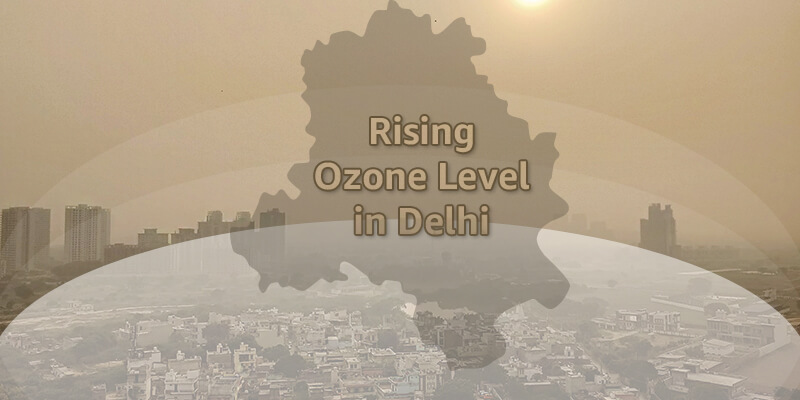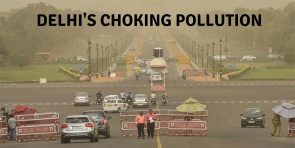Ground Level Ozone – a Deadly Air Pollutant that’s Posing a Serious Threat in Delhi
Delhi, a city that is always in the grip of deadly pollution, has seen a deadly increase in ozone levels. Not just Delhi, but several other cities such as Faridabad, Gurugram, Ghaziabad, and Noida have also witnessed a spike in the ozone level. The serious situation has, in fact, become a topic of discussion in Lok Sabha during the current Parliament session. An analysis by the Centre for Science and Environment, New Delhi has revealed that many densely populated areas have exceeded the ozone standards after analyzing the past 12 days. Considering the alarming situation, we will discuss in detail the causes, effects, and solutions for ozone pollution.
World Ozone Day- Theme and Importance
Also known as the International Day for the Preservation of Ozone Layer, the United Nations General Assembly designated September 16th as World Ozone Day. The day was designated in memory of when nations inked the Montreal Protocol on Substances that lead to Ozone Layer Depletion.
The theme of this year’s World Ozone Day 2019 is- 32 Years and Healing. The theme celebrates more than three decades of international cooperation to protect the climate and ozone layer under the Montreal Protocol. The Protocol has been successful in phasing out 99 percent of ozone-depleting chemicals in different products such as air coolers and refrigerators.
The Rising Risk of Ozone Pollution in Delhi
High pollution, rising temperature levels, and heat waves have increased the formation of ozone and exceeded the standards. Dwarka, Ashok Vihar, Bawana, Vivek Vihar, and Sri Aurobindo Marg are some of the locations that have noticed an increase in the ozone level. In fact, 38 percent of the 36 locations have exceeded the eight-hour average standard of ozone. According to the AQI data released by CPCB, ozone and PM 2.5 have been the prominent pollutants between April 11 to June 5, 2019. The highest concentration of ozone in 2019 went up to 122 micrograms per cu m. This is 1.22 times higher than the eight-hour average exposure is 100 micrograms per cu m. The eye-opening year-to-year comparison table will give a clear idea about the number of days some of the prominent cities have witnessed increases in ozone levels:
| City | 2016 | 2017 | 2018 | 2019 (May 31) |
| Delhi | 36 | 14 | 45 | 23 |
| Faridabad | 3 | 0 | 8 | 55 |
| Gurugram | 43 | 0 | 5 | 6 |
| Ghaziabad | – | 0 | 8 | 3 |
| Noida | – | 33 | 16 | 0 |
(Source: Central Pollution Control Board via MoEF)
What Causes Ground-Level Ozone Pollution?
Ozone (O3), composed of three atoms of oxygen, is not directly emitted into the atmosphere. Ground-level ozone is created as a result of a reaction between nitrogen oxide (NOX) and volatile organic compounds in sunlight. Ground-level ozone is considered bad as it leads to a number of problems. Industrial emissions, motor vehicle exhaust, chemical solvents, and gasoline vapor emit ground-level ozone. Natural sources such as NOX and VOC also emit ground-level ozone. The primary constituent of smog is ground-level ozone. Heat waves, sunlight, and hot weather along with ground-level ozone lead to the formation of harmful concentrations in the air. This is the reason why ground-level ozone is also known as a summertime pollutant.
The Health Effects of Ozone Air Pollution
High levels of ozone present in the atmosphere have a negative effect on health. People suffering from asthma, children, older adults, and people indulging in outdoor activities are at a higher risk of ozone pollution. Breathing ozone can lead to the following problems:
- Chest pain
- Coughing
- Throat irritation
- Inflammation in the airway
- Affect the lung function
- Harm the lung tissues
- Worsen bronchitis, emphysema, and asthma
- Increase the frequency of asthma attacks
- Chronic obstructive pulmonary disease (COPD)
Does Ozone Pollution Affect Indoor Air?
The high level of air pollution has a negative impact on indoor air and leads to a number of health problems. The outdoor air pollutants infiltrate into your home in a number of ways such as open windows, doors, cracks in the walls, and window sealants. Ground-level ozone and other gases, which penetrate into your home using the ventilation process, react with the chemicals present in the building and create harmful chemical byproducts. Research shows that indoor ozone, present even at low levels, can lead to a number of health problems such as trigger asthma and respiratory problems.
How can you protect yourself from high ozone levels
The best way to reduce exposure to rising ozone pollution during summer is to monitor the ozone levels in your area and take the required action. Here are a few useful suggestions to stay safe from ozone pollution:
Monitor the Air Quality
The first step is to monitor the air quality of the area where you live. There are websites that provide you with information about air quality and ozone levels.
Stay Indoors
If possible, stay indoors when pollution is high. As per EPA, the concentration of ozone indoors varies between approximately 20-80% of the outdoor level. However, this percentage also depends on whether the windows are open or closed, or an air conditioning system is used.
Use an Air Purifier
Air purifiers with activated carbon filters are effective in removing ozone. The activated carbon filters contain bituminous coal that reduces the level of ozone in your home. The air purifiers from KENT are highly effective in keeping the indoor air clean and removing different types of pollutants.
Last Few Words
Ozone is a deadly gas and even a short duration of exposure to ozone worsens asthma and respiratory conditions. Considering the alarming situation, it’s high time to take the right steps such as reducing emissions and burning waste. Controlling the current situation will make a constant effort and time, however, taking these small steps will ensure that the problem doesn’t increase in the coming years and pose a risk to mankind.





